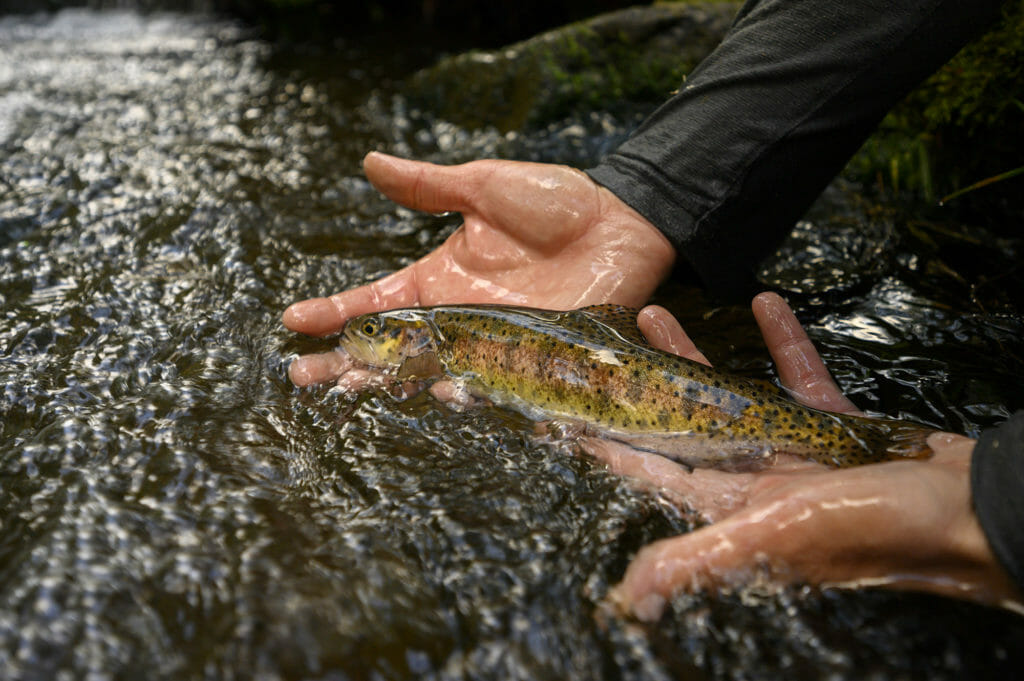Conservation success and concern for Lahontan cutthroat trout
Daniel Ritz is fishing across the Western United States this summer in an attempt to reach the Master Caster class of the Western Native Trout Challenge, attempting to land each of the 20 native trout species in their historical ranges of the 12 states in the West. You can follow Ritz as he travels across the West by following Trout Unlimited, Orvis, Western Native Trout Challenge and Montana Fly Company on social media using #WesternTroutChallenge.
Back in February and neck deep in planning my Western Native Trout Challenge adventure I found plenty of motivation from the first destination on the schedule.
It was prime season for trophy Lahontan cutthroat trout at Pyramid Lake in Nevada, and I was determined to kick the journey off with an epic trip. I had no idea exactly how epic, and how different, my Lahontan cutthroat journey would become.
“I’m going to catch the biggest damn cutthroat in the world,” I had been telling friends and family when they asked why I was pursuing windburn and frozen fingers near Reno in the depth of winter on a terminal lake.
Days away from my trip to Pyramid I reached out to Jason Barnes, Trout Unlimited’s Lahontan cutthroat trout biologist.
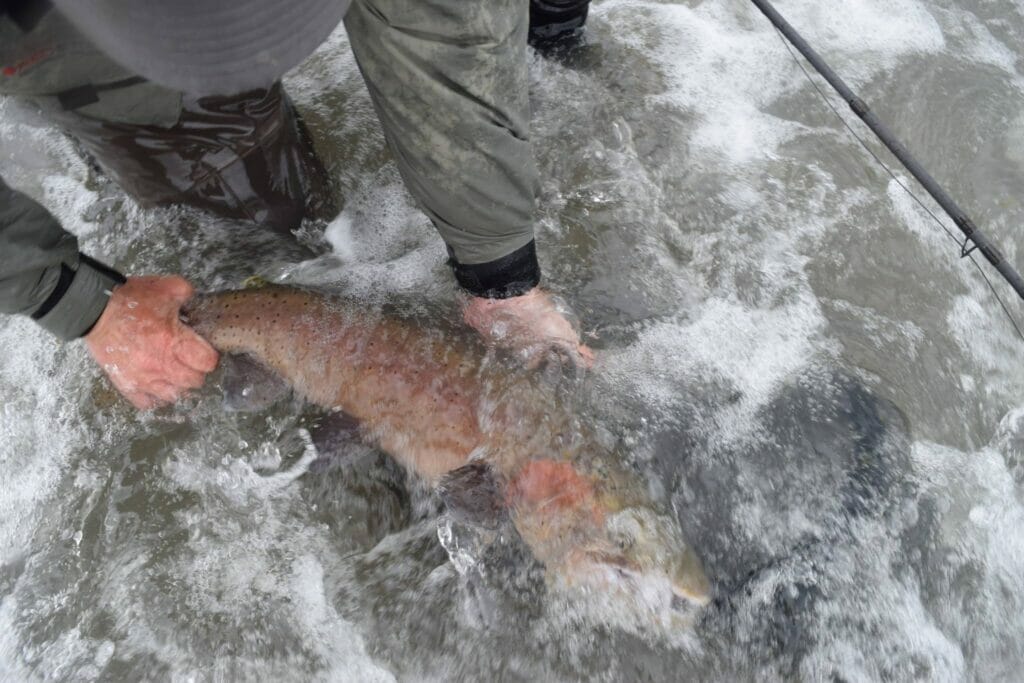
“Pyramid is great,” Barnes said, “but it isn’t the entire Lahontan story.”
My conversation with Barnes set the stage for an experience that would take me far from Pyramid Lake and a long way from any record-breaking cutthroat trout.
But first, back to February. Considered extirpated from Pyramid Lake in 1943, it wasn’t until the 1970s that a hatchery population of Lahontans made it back into the lake. Cutthroat from high-country streams and lakes in eastern California and western Nevada, were used to repopulate Pyramid Lake. These were not the fish historically found in Pyramid that grew to enormous sizes like the 41-pound Lahontan caught in 1925. There are also credible reports of Lahontans double that size.
For many years, it was thought the ancestral Pyramid Lake Lahontan population had been lost forever. However, during the late 1980s fish with original Pyramid Lake Lahontan genetics were found at Pilot Peak deep in the West Desert of Utah.
The return of these native trout to their native spawning waters in the Truckee River in 2014 marked the first natural reproduction of wild Pyramid Lake Lahontan cutthroats since the 1930s.
That said, while increasing in number, naturally reproducing fish cannot sustainably support the current Pyramid Lake population that is attracting anglers from across the world, myself included. The Lahontan National Fish Hatchery Complex raises these fish in a partnership between the U.S. Fish & Wildlife Service, the Bureau of Reclamation and the Pyramid Lake Paiute Tribe. The large lake is contained within the Pyramid Lake Indian Reservation and the tribe manages the fishery. Special rules – the fishing season for trout runs from Oct. 1 to June 30 – a tribal permit is required.
A few weeks after my call with Barnes I was startled from sleep before sunrise on the beach at Pyramid Lake. Vibrations of 4 x 4s and the smell of diesel were not quite the way I expected to rise on the first day. I leapt out of my tent, prepared to take part in what surely had to be the greatest comeback story in the history of the world, let alone for native trout in Nevada.
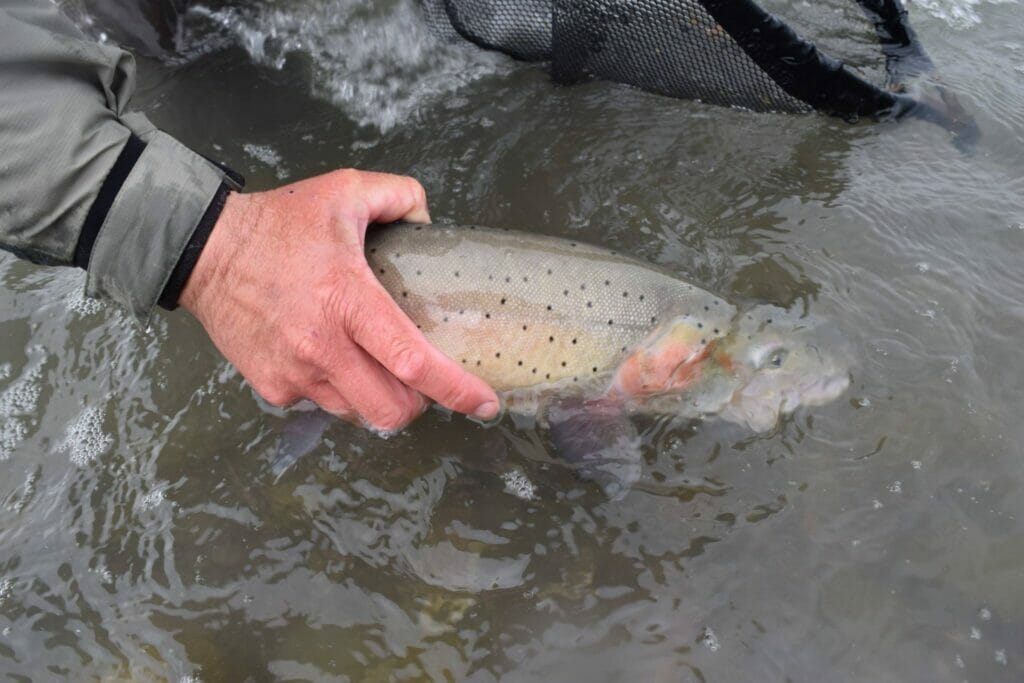
Everything you wanted to know: Lahontan cutthroat trout
After fighting a ferocious headwind for most of the morning which easily overwhelmed my weak (note: non-existent) two-handed casting skills, I decided to swallow my pride and tuck-tail from prime position and retreat to a cove sheltered from the roaring wind. Shortly after relocating, the bobber plunged below the surface as a fish the weight of which I had never felt was tugging on the line.
As I slowly, carefully drew in the bulldogging fish, I was able to finally catch a glance and could see I had connected with a beautiful, chrome-colored summit (the high-country version) strain Lahontan. After getting the fish to net, tough to do in and of itself while shaking from excitement from atop a 6-foot ladder, we quickly took a few photos before sending her off on her way.
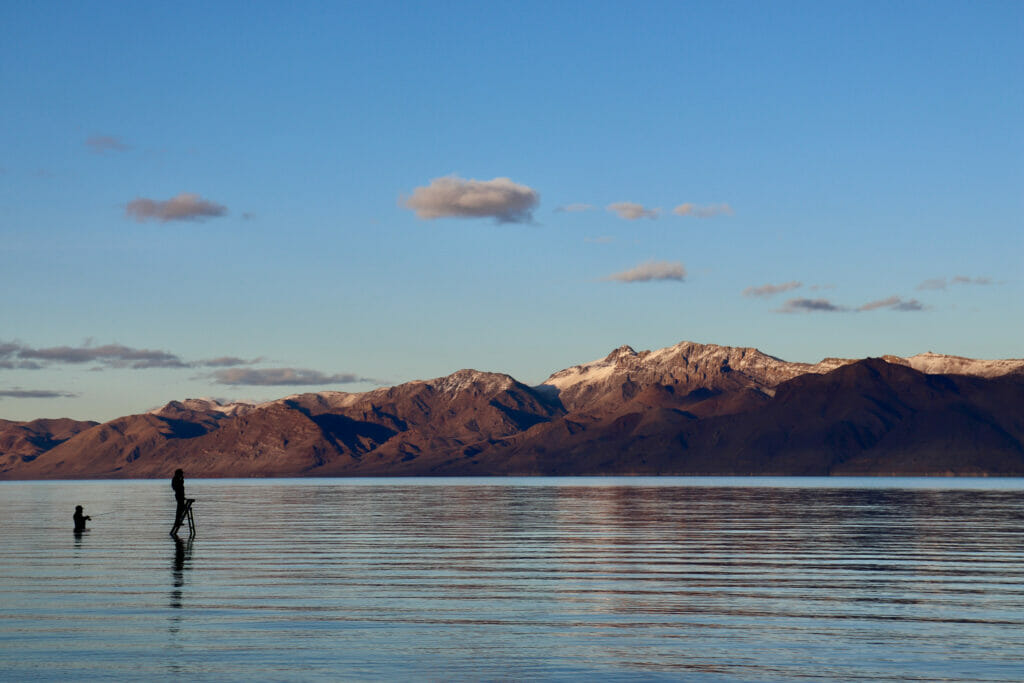
Throughout the day, I was lucky enough to locate and bring a few more fish to hand, all beautiful in their own right, including a few of the aforementioned Pilot Peak strain which showed a wider range of color.
Later that night, I sat emotionally drained as a seemingly endless parade of trucks in need of emissions tests loaded with commercial-grade coolers and rod vaults looking as if they were made by NASA drove between the door to my tent and a now breathtaking snowy sunset.
All day, flanked by my fellow hero-shot-thirsty anglers, I had felt that something just didn’t quite feel right. Was this really the phoenix from the ashes, “rescued from extinction” native trout story I had come here for? On the other hand, who was I to project what a new experience “should” be like?
Nevertheless, I couldn’t get over that it all felt like such a production. The “production” was precisely the aspect of the “rescued from extinction” story that Barnes had warned me of.
One might think, as I did, of Nevada and the Great Basin as one single, endless expanse. The irony is how radically untrue this was for the trout that originally inhabited its waters. For example, the Conservation of the Lahontan cutthroat trout report prepared by the Lahontan Cutthroat Trout Coordinating Committee in 2019 states that in 1800, it is believed that more than 370,000 surface acres of lake (in 12 larger lake systems) and more than 7,400 miles of stream/river habitat was occupied or had the potential to be occupied by Lahontan cutthroat trout. That same report states that at least 42 of the approximately 72 still-existing populations of Lahontans within the historical range are now present in small, isolated habitat fragments.
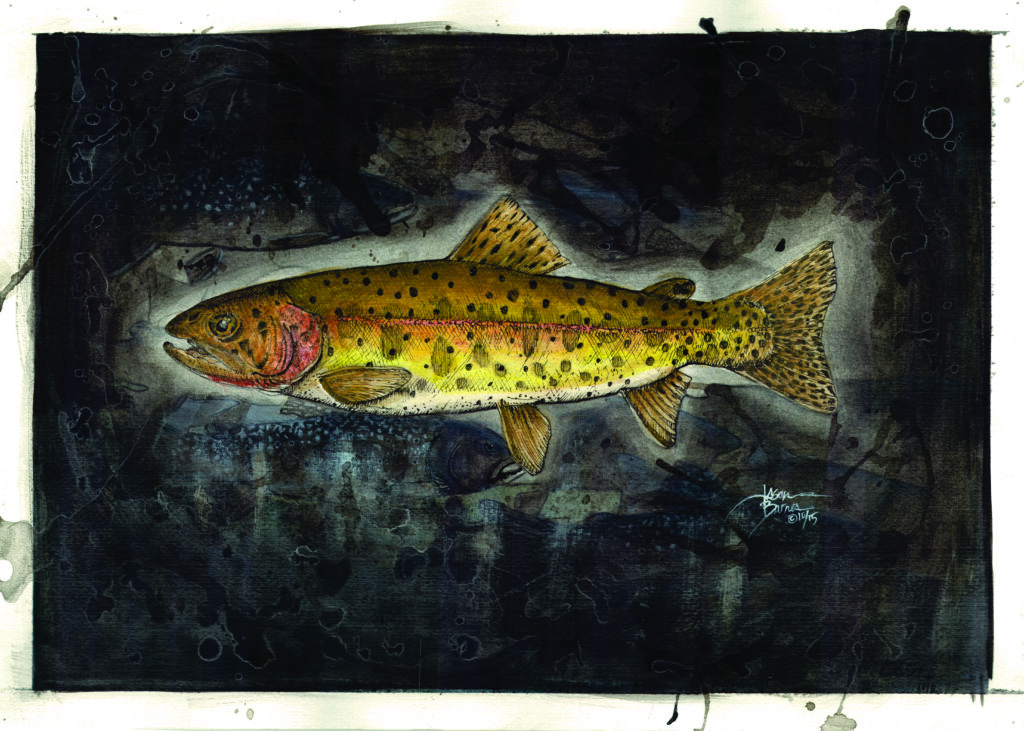
“Things worth having are things worth earning,” I remembered Barnes saying.
Early the next morning I packed up camp and drove home to begin again. The hard way.
The Monday following my Pyramid Lake experience, my very first call was to Jacob Stoller, a fisheries biologist who manages most of the fisheries in Northeast Nevada above Interstate-80 for the Nevada Department of Wildlife. During a discussion about the native trout in his region, Stoller mentioned that it’s a rare day when he receives a call from traveling anglers about Lahontans compared to other gamefish in Nevada.
Six weeks later, I blatantly disregarded Stoller’s advice to avoid the mud and stream swell of runoff season in the high desert near Elko, Nev. As I rolled along the Upper Owyhee River, my mind began to wander to old newspaper clippings I had been forwarded from publications such as the Elko Independent reporting salmon runs so thick they would in fact “dam” that same river.
https://trout.maps.arcgis.com/apps/View/index.html?appid=b5e3bfd9ecd64d50bf473fc4fbf9bfd5&extent=-168.0388,31.1402,-90.0799,68.3071%27Salmon migrating to spawn all the way down the Columbia River basin played a large economic role in northeast Nevada, particularly for the native Americans of what is now the Duck Valley Reservation until the runs began to dwindle around 1900. I couldn’t help but wonder how far we’ve come from a time when fish traveled from the Pacific Ocean to Nevada via the Columbia Basin, and how I now had to drive more than 300 miles between locations for the same species.
After turning east off Nevada State Route 225, still miles from my destination, my hubris finally got the best of me when I became stuck atop a snow drift on the first north facing slope I could find. By this point, I had driven well over 1,000 miles in pursuit of these trout, but I knew that I would be going no further that night. In that moment, my awareness of the region’s isolation reached new heights.
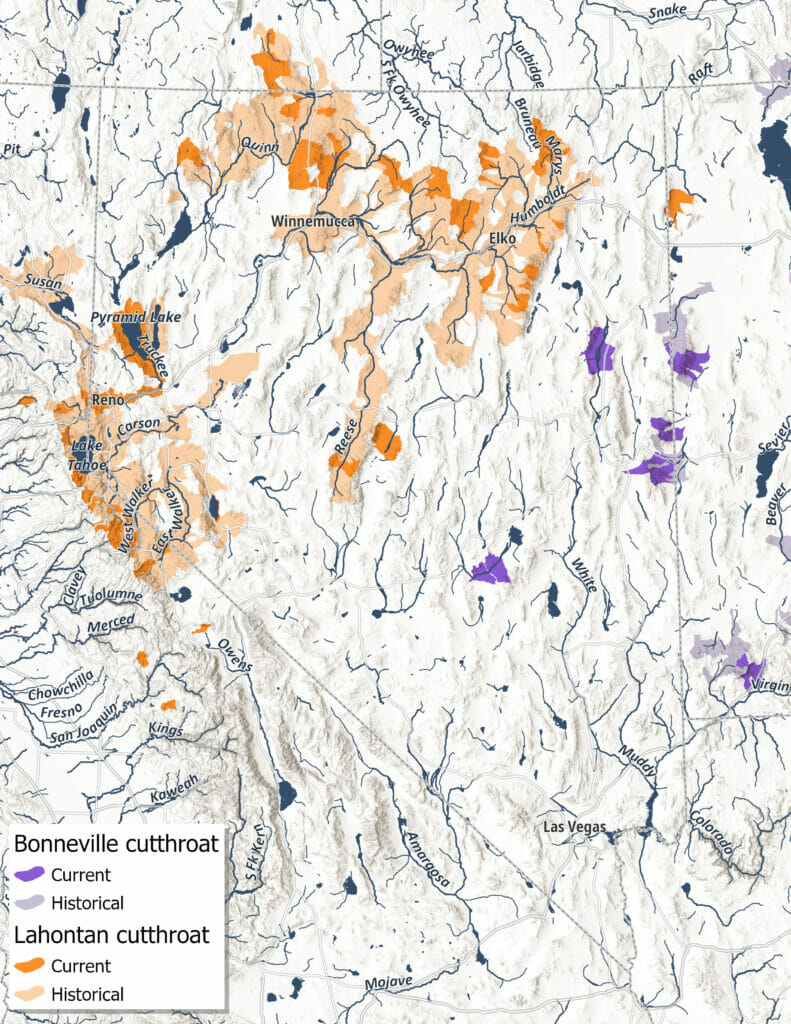
The next morning, unsure of the path ahead, I broke camp earlier than I probably needed to and took off on foot to walk the three miles I should have been able to drive and proceeded to posthole all the way to the confluence of two headwater creeks where I hoped to find fish. I proceeded to immediately donate a half-dozen of my best flies to the surrounding trees and brush before beginning to relax and walk the stream. Finally, I literally stumbled across a bend in the stream, not visible from the trail I took to get there, where a thigh-deep and crystal clear pool had formed thanks to an industrious beaver.
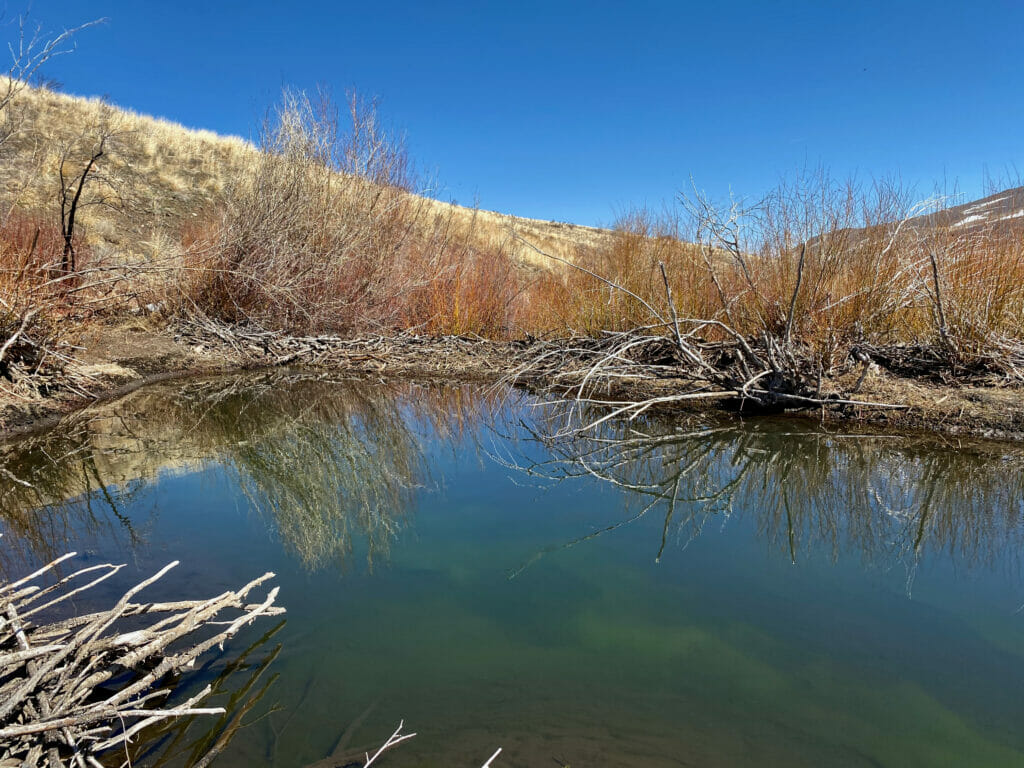
On the deep side of the bend across from me, I was delighted to see a neat feeding line of maybe a dozen 6- to 8-inch trout. Never having seen one of this form before, I was confident they were native Lahontans solely based on how naturally they blended into the stream bottom.
The night prior, due to a small rip in the mesh door of my tent, I had noticed what looked to be dark colored skwalas flying about inside my tent, so I tied on a simple midge nymph below a nondescript battered skwala on the line and prayed I didn’t hand deliver my rig to the tree behind me.
The next to last fish in the feeding line casually slurped the nymph with grace. Quickly pulling the eager 5-inch trout to the net, I sunk to my knees. I barely remember bringing the small fish to rest in the net as its vibrant colors took me to another place.
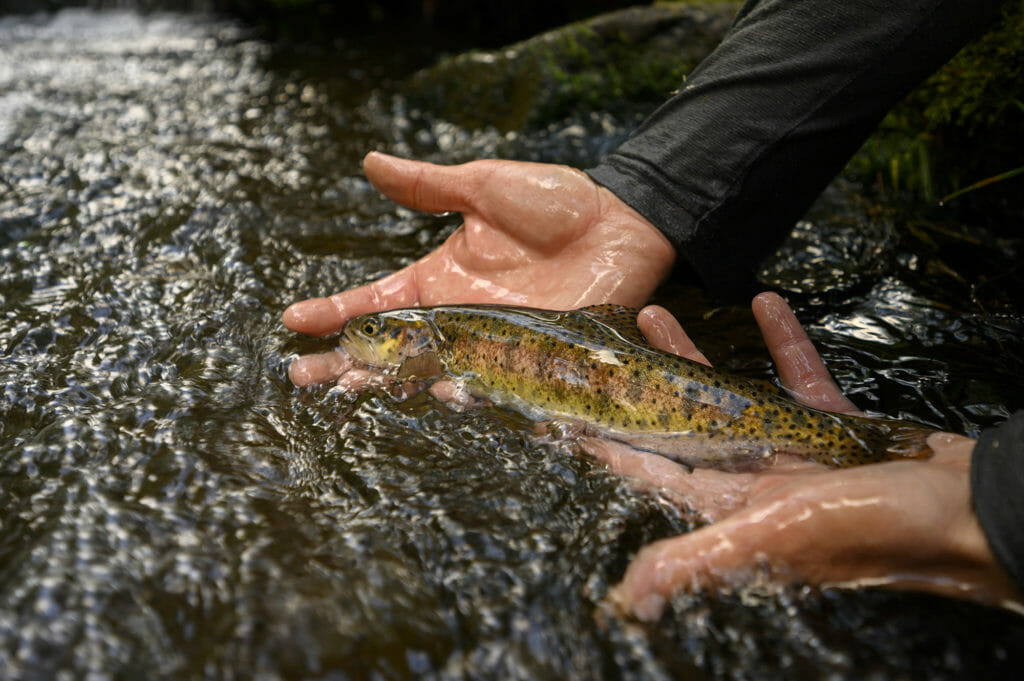
In that moment, in its piercing yellow eyes I could see millennia of survival and perseverance.
I fished my way back to camp, hopping from pool to pool, now adjusted to that unique pace small-stream fishing requires.
Later in the day, at the same beaver pool at the confluence of the two headwater creeks where I had started the day, the water was now murky with run off, and 6- to 8-inches higher than it was that morning due to the pristine 75 degree spring conditions.
My head began to race with thoughts of getting trapped in the backcountry by a muddy impasse. I made an executive decision that I had pushed my luck far enough. None of us are too good for the “one more,” cast, though. I slowly jigged a smaller streamer through the pool to see if I could coax one last native to the fly before departing. Not seconds later, the largest Lahontan I had seen all day inhaled the Thin Mint Wooly Bugger I had tied on and proceeded to leap repeatedly from the pool.
Driving home later that night and early into the next morning, I revisited the panicked feeling I had experienced as I sat resting my hands; blistered and splintered from the supposed-to-be firewood I had to use to dig out the tires and then provide traction to get my almost 5,000-pound vehicle out of the snow just one day before. I remembered, as the sun set behind Wheeler Mountain and I pondered if that was exactly where I was sleeping that night, how very far I felt from the bright lights of Reno and the hoots of “fish on!” at Pyramid Lake.
“When you go out there and see where these fish live, you get to have a personal experience of how these fish live,” Barnes had said.
Sometimes you get what you ask for. Sometimes you get much more, but my experience pursuing Lahontans served me a reminder that things worth having are always worth earning. One way or another, continuing the opportunity to experience Lahontan cutthroat trout in Nevada is going to take a lot of work I suppose it just depends if you want part of the story or the whole story.



